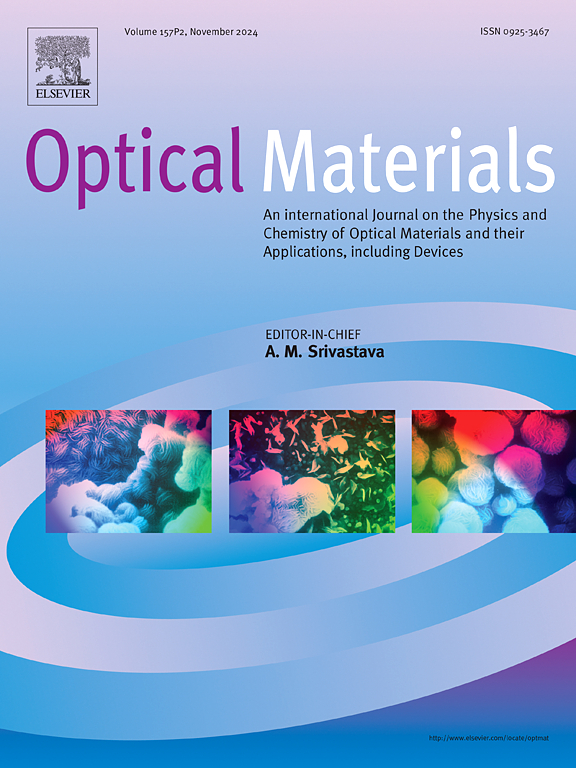Improvement the optoelectronic properties of chitosan biopolymer using natural dye of black olive as a novel approach: FTIR, XRD and UV–vis spectroscopic studies
IF 3.8
3区 材料科学
Q2 MATERIALS SCIENCE, MULTIDISCIPLINARY
引用次数: 0
Abstract
The current study brings new knowledge about the role of natural waste dyes in modifying the optoelectronic properties of biodegradable polymers. The black olive dyes (BODs) were extracted using distilled water. Solution cast technique was used to fabricate Chitosan (CS) CS:BOD films with enhanced absorption character. The extracted BODs were examined using FTIR routine to identify functional groups such as OH/NH, C![]() O, CH, and CH2. The bands observed in FTIR spectra of CS:BOD films confirmed the existence of huge functional groups in the BODs. X-ray diffraction (XRD) analysis revealed that doping CS with BOD leads to change in structure and the regular molecular arrangement in CS. UV–vis spectra of pure BODs and pure CS were compared. The UV–vis spectra CS:BOD films reveal increased absorption while transmittance decreased. The absorption edge shifted to lower photon energy, and the Urbach energy was used to calculate the steepness () and of the electron-phonon interaction () parameters. The refractive index and the angle of refraction of the rays emitted from the film's backside were studied. Various models correlating the energy gap to calculate the refractive index were investigated. The optical spectral moments and have been determined utilizing the and values obtained from the Wemple-DiDomenico (W-D) model. Optical dielectric loss, the Tauc model, and the absorption spectrum fitting (ASF) strategy were used to determine the optical band gap and specify the dominant type of transition associated with transition electrons. The values in eV for damping frequency (), plasma energy (), valence electron plasma energy (), Penn energy, and Fermi energy () were determined. The sheet resistance () and the thermal emissivity () were determined with the help of refractive index and transmittance parameters. The figure of the parameter is clearly used to distinguish the optical properties of the pure polymer in comparison to that of the doped one. Enhanced first and third-order nonlinear optical susceptibility ( and ) and nonlinear refractive index () indicate the applicability of CS:BOD films for nonlinear applications such as waveguides, filters, modulators, and storage systems.
O, CH, and CH2. The bands observed in FTIR spectra of CS:BOD films confirmed the existence of huge functional groups in the BODs. X-ray diffraction (XRD) analysis revealed that doping CS with BOD leads to change in structure and the regular molecular arrangement in CS. UV–vis spectra of pure BODs and pure CS were compared. The UV–vis spectra CS:BOD films reveal increased absorption while transmittance decreased. The absorption edge shifted to lower photon energy, and the Urbach energy was used to calculate the steepness () and of the electron-phonon interaction () parameters. The refractive index and the angle of refraction of the rays emitted from the film's backside were studied. Various models correlating the energy gap to calculate the refractive index were investigated. The optical spectral moments and have been determined utilizing the and values obtained from the Wemple-DiDomenico (W-D) model. Optical dielectric loss, the Tauc model, and the absorption spectrum fitting (ASF) strategy were used to determine the optical band gap and specify the dominant type of transition associated with transition electrons. The values in eV for damping frequency (), plasma energy (), valence electron plasma energy (), Penn energy, and Fermi energy () were determined. The sheet resistance () and the thermal emissivity () were determined with the help of refractive index and transmittance parameters. The figure of the parameter is clearly used to distinguish the optical properties of the pure polymer in comparison to that of the doped one. Enhanced first and third-order nonlinear optical susceptibility ( and ) and nonlinear refractive index () indicate the applicability of CS:BOD films for nonlinear applications such as waveguides, filters, modulators, and storage systems.
求助全文
约1分钟内获得全文
求助全文
来源期刊

Optical Materials
工程技术-材料科学:综合
CiteScore
6.60
自引率
12.80%
发文量
1265
审稿时长
38 days
期刊介绍:
Optical Materials has an open access mirror journal Optical Materials: X, sharing the same aims and scope, editorial team, submission system and rigorous peer review.
The purpose of Optical Materials is to provide a means of communication and technology transfer between researchers who are interested in materials for potential device applications. The journal publishes original papers and review articles on the design, synthesis, characterisation and applications of optical materials.
OPTICAL MATERIALS focuses on:
• Optical Properties of Material Systems;
• The Materials Aspects of Optical Phenomena;
• The Materials Aspects of Devices and Applications.
Authors can submit separate research elements describing their data to Data in Brief and methods to Methods X.
 求助内容:
求助内容: 应助结果提醒方式:
应助结果提醒方式:


